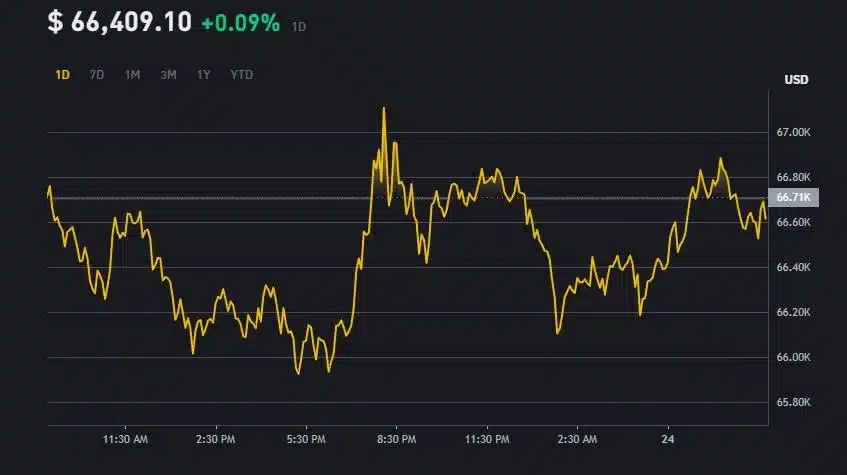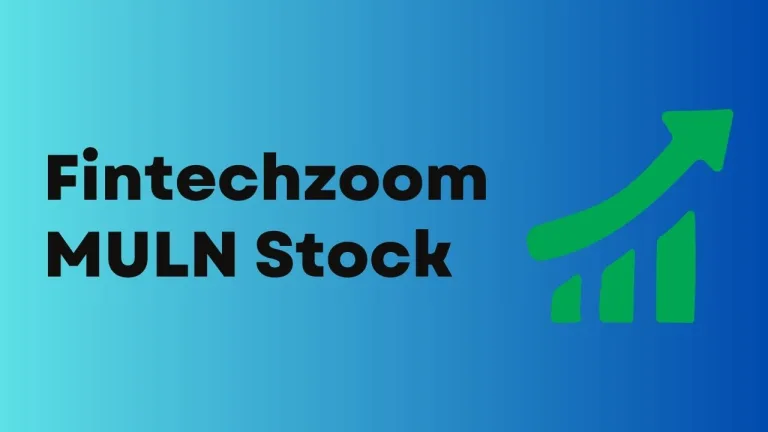Fintechzoom Bitcoin Price Analysis and Predictions [2024]
In this article on Fintechzoom, we’ll provide a complete analysis of Bitcoin price, including current market conditions, factors influencing its valuation, expert predictions for the coming years, and insights into its investment viability.
Bitcoin, the world’s first and most famous cryptocurrency, has continued to dominate the financial headlines with its dynamic price movements and significant role in the digital economy.
Initially introduced in 2009, Bitcoin has evolved from a niche internet curiosity into a major financial asset that commands the attention of both individual and institutional investors. As of April 2024, Bitcoin’s influence spans various sectors, impacting investment strategies, monetary policies, and even global economic stability.
Despite periodic fluctuations, Bitcoin’s resilience is evident in its recovery and growth phases, often mirroring or even influencing broader market trends. The cryptocurrency’s decentralized nature offers an alternative to traditional financial systems and introduces a level of financial autonomy previously unavailable.
Bitcoin (BTC) Current Market Overview

As of the latest data in April 2024, Bitcoin is trading at approximately $47,000, marking a significant recovery from earlier lows. This price level reflects a steady increase over the past several months, spurred by favorable market conditions and growing investor interest. Bitcoin’s market capitalization currently stands at around $890 billion, with daily trading volumes often exceeding $40 billion. These figures highlight Bitcoin’s significant presence and activity in the cryptocurrency market.
The cryptocurrency has seen varied performance across different periods, with price swings influenced by investor sentiment, regulatory news, and technological developments. Its ability to maintain a high market cap despite these fluctuations speaks to its established position and the confidence that investors place in it. Bitcoin’s performance is not just a reflection of investor speculation but also an indicator of its adoption across various applications, from online transactions to being a reserve asset for some companies.
Fintechzoom Bitcoin Historical Price Performance Analysis
Examining the historical price performance of Bitcoin provides valuable insights into its potential future movements. Bitcoin’s journey from a few cents in 2009 to nearly $65,000 in 2021 showcases an asset capable of remarkable growth and significant volatility. This historical perspective is essential for understanding the factors that could drive future price changes.
Over the years, Bitcoin has experienced several major bull runs, typically followed by substantial corrections. For instance, the late 2017 surge to nearly $20,000 was a milestone that brought widespread attention to cryptocurrency, followed by a sharp decline throughout 2018 where prices bottomed out around $3,200. Similarly, after reaching highs in 2021, Bitcoin experienced a downturn, reflecting broader economic uncertainties and shifts in investor sentiment.
Key drivers of these price movements include technological advancements, macroeconomic factors, and shifts in regulatory landscapes. Each bull run coincided with significant developments within the blockchain ecosystem, such as the introduction of new platforms or enhancements to Bitcoin’s own network. Moreover, macroeconomic factors like inflation and currency devaluation in various countries often correspond with increased investment in Bitcoin, pushing prices upward.
Analyzing these patterns helps in predicting future trends. While past performance is not always indicative of future results, Bitcoin has shown a consistent ability to recover and reach new highs after each downturn. This resilience suggests that despite its volatility, Bitcoin remains a compelling asset for both short-term traders and long-term investors.
Fintechzoom Bitcoin Price Predictions
The landscape of Bitcoin price predictions for 2024 is vast and varied, encompassing a wide range of viewpoints from conservative estimates to bullish forecasts. Fintechzoom has projected that Bitcoin price could reach as high as $150,996 by the end of 2025, starting with a significant rise in 2024. Such optimistic predictions stem from a combination of market momentum, technological adoption, and macroeconomic factors that favor cryptocurrencies.
On the more immediate horizon, the average prediction by Fintechzoom for Bitcoin price by the end of 2024 stands around $109,141. This figure represents a consensus from diverse financial experts and Fintechzoom analysts who consider current trends and upcoming events that could influence Bitcoin’s valuation. Factors fueling these projections include the anticipated impact of Bitcoin halving events, which historically have led to substantial price increases, and the growing acceptance of Bitcoin ETFs which facilitate easier access to the cryptocurrency market for institutional investors.
Conversely, there are also more conservative voices in the financial community. Some analysts predict potential lows if adverse economic conditions prevail or if regulatory challenges emerge. For instance, the most bearish of panelists see potential scenarios where Bitcoin could retract to below $20,000 due to market corrections or negative regulatory developments.
Despite these varied predictions, the overall sentiment remains predominantly positive, reflecting a strong belief in Bitcoin’s foundational technology and its role as a pioneer in the cryptocurrency space. This optimism is underpinned by Bitcoin’s proven track record of resilience and its ability to navigate past economic and regulatory challenges.
Fintechzoom Bitcoin Price Long-term Predictions (2025-2030)
Looking beyond 2024, Fintechzoom long-term predictions for Bitcoin price range from cautiously optimistic to exceptionally bullish, reflecting the diverse perspectives within the investment community.
By 2025, Fintechzoom forecasts suggest that Bitcoin price could reach $150,996, with projections for 2030 going as high as $567,489. These predictions are based on current trends in market adoption, technological advancements, and macroeconomic factors that are expected to influence Bitcoin’s utility and desirability.
Several factors contribute to these optimistic long-term forecasts:
- Increasing Institutional Adoption: As more financial institutions begin to offer cryptocurrency services and adopt Bitcoin as a reserve asset, its price is expected to rise due to increased demand and reduced volatility.
- Technological Improvements: Continued innovations within the Bitcoin network, like enhancements to scalability and security, are likely to attract more users and boost the cryptocurrency’s price.
- Macroeconomic Conditions: Bitcoin is increasingly viewed as a hedge against inflation and currency devaluation. As global economic uncertainties persist, Bitcoin could benefit from heightened demand similar to other safe-haven assets like gold.
Despite these positive indicators, there are also more conservative estimates that suggest a potential drop in prices if adverse conditions prevail. Challenges such as regulatory crackdowns, technological setbacks, or a shift in investor sentiment could negatively impact Bitcoin’s price.
Additionally, the evolving landscape of cryptocurrencies and the introduction of new technologies or competitors could influence Bitcoin’s dominance and price stability.
Understanding the potential highs and lows is crucial for investors considering long-term positions in Bitcoin. While the outlook remains generally positive, the inherent volatility and unpredictability of cryptocurrencies mean that these investments should be approached with caution and a well-considered strategy.
Investment Analysis
When analyzing Bitcoin as a potential investment, it’s important to weigh both the opportunities and risks. Bitcoin’s past performance demonstrates significant growth potential and resilience in recovering from sharp declines. However, its price volatility remains a considerable risk factor. For those looking at Bitcoin as a long-term investment, the key is to consider its role within a diversified portfolio, possibly allocating a portion that matches one’s risk tolerance and investment horizon.
Moreover, Bitcoin’s independence from traditional financial systems and its limited supply cap at 21 million coins make it an attractive alternative investment. Its qualities as a decentralized and non-sovereign asset can provide a hedge against economic instability and inflation, contributing positively to its investment appeal.
In conclusion, while the long-term prospects for Bitcoin appear promising, investors should remain vigilant and informed about the factors that could impact its price. Regularly reviewing and adjusting one’s investment approach in response to new data and market conditions is advisable to navigate the complexities of the cryptocurrency market effectively.
Which Factors Influence Bitcoin’s Price?
Economic Factors
The price of Bitcoin is significantly influenced by global economic factors, which can either enhance or diminish its value depending on the broader financial climate. For instance, inflation rates across major economies can lead to increased interest in Bitcoin as a potential hedge against currency devaluation. During periods of high inflation, Bitcoin often sees a surge in price as investors look for safe havens for their capital. Additionally, geopolitical tensions often drive investors towards cryptocurrencies as alternatives to traditional assets like gold, silver, or the stock market, which may be perceived as vulnerable in uncertain times.
Technological Developments
Technological advancements also play a crucial role in shaping Bitcoin’s price. Upgrades to the Bitcoin network, such as improvements in scalability and security, can make it more attractive to users and investors, thereby potentially increasing its price. Conversely, technological issues or delays in planned updates can have a negative impact. The crypto community closely watches developments like the integration of the Lightning Network, which promises faster transactions and lower fees, potentially boosting Bitcoin’s utility and, consequently, its market value.
Regulatory Environment
Regulation is perhaps one of the most significant external factors affecting Bitcoin. Positive regulatory developments, such as the approval of Bitcoin ETFs or clear legal frameworks for cryptocurrencies, generally lead to price increases. In contrast, strict regulations or negative statements from key financial authorities can cause uncertainty and fear, leading to price drops. For example, announcements of investigations or bans in major markets like China or the U.S. have historically led to sharp declines in Bitcoin prices.
Each of these factors interplays uniquely to influence Bitcoin’s market price, making its trajectory a subject of keen interest and speculation among investors. As we continue to monitor these influences, the dynamic nature of Bitcoin’s valuation becomes a critical aspect of both its appeal and its risk.
Bitcoin Halving Event
The Bitcoin halving event is a significant occurrence in the cryptocurrency world that directly impacts Bitcoin’s supply and, by extension, its price. Scheduled approximately every four years, a halving reduces the reward for mining new blocks by 50%. This mechanism is designed to control inflation and mimic the scarcity-driven appreciation typical of precious resources like gold.
The most recent halving events have historically led to substantial price surges. For instance, post-halving in 2016, Bitcoin’s price rose dramatically over the next year, and a similar pattern occurred following the 2020 halving. These price movements are largely attributed to the reduced rate at which new Bitcoins are generated, which diminishes supply and can lead to higher prices if demand remains strong.
Experts often view halvings as bullish events for Bitcoin’s price due to this supply shock. As fewer new coins enter the system, assuming demand holds steady or increases, the price naturally tends to rise. This anticipation often leads to increased buying activity in the months leading up to a halving, as investors aim to capitalize on the expected price increases.
Furthermore, halvings also highlight Bitcoin’s deflationary nature, reinforcing its appeal as a ‘digital gold.’ As the total supply edges closer to its 21 million coin cap, each halving event underscores the cryptocurrency’s scarcity, potentially boosting investor interest further.
The impact of these events extends beyond just price. They are pivotal in maintaining the security of the Bitcoin network, ensuring that mining remains economically viable for participants despite the decreasing block reward. This balance is critical for the long-term health and stability of the Bitcoin network.
Bitcoin and ETFs
The integration of Bitcoin into the world of Exchange-Traded Funds (ETFs) marks a significant milestone in its acceptance as a mainstream financial asset. Bitcoin ETFs allow investors to gain exposure to Bitcoin’s price movements without the complexities of direct cryptocurrency ownership, such as managing wallets and keys. This development has opened the door for a broader range of institutional and retail investors to enter the cryptocurrency market.
The approval of Bitcoin ETFs has had a palpable impact on the market. For example, the launch of the first Bitcoin futures ETFs in the United States in late 2021 catalyzed a surge in Bitcoin’s price, as it facilitated increased institutional investment. These ETFs track the price of Bitcoin futures rather than the cryptocurrency itself, providing a regulated avenue for investor exposure to Bitcoin.
More recently, investors have anticipated and eventually welcomed the approval of Bitcoin spot ETFs that invest directly in Bitcoin rather than in derivatives. These approvals are expected to bolster investor confidence and broaden Bitcoin’s investor base further. Viewed as a more direct and, therefore, more attractive investment, spot ETFs could potentially reduce the premiums often associated with futures-based products.
The effect of ETFs on Bitcoin’s market dynamics cannot be overstated. They provide increased liquidity, enhance price discovery, and most importantly, offer a stamp of legitimacy to Bitcoin in the eyes of skeptical institutional investors. Additionally, ETFs are crucial in reducing the volatility of Bitcoin by smoothing out price fluctuations through steady, institutional capital flows rather than speculative retail trading.
This broadening of access through ETFs continues to support Bitcoin’s price by simplifying the investment process and providing a safer, regulated way for more people to invest in Bitcoin. As more ETFs are introduced and gain traction, they are likely to further integrate Bitcoin with the broader financial markets.
Frequently Asked Questions (F.A.Q)
Is it too late to invest in Bitcoin?
One common question among potential investors is whether it’s too late to get into Bitcoin. The answer largely depends on market conditions and individual investment goals. Historically, Bitcoin has shown remarkable growth, reaching all-time highs followed by corrections. While past performance is not indicative of future results, Bitcoin’s finite supply and increasing adoption suggest that it still holds significant growth potential. However, potential investors should consider their risk tolerance and investment timeframe, as Bitcoin’s volatility can lead to substantial gains or losses.
How do Bitcoin halvings affect the price?
Bitcoin halvings are anticipated events that reduce the reward for mining new blocks in half, effectively decreasing the rate at which new Bitcoins are created. This event tends to have a bullish effect on Bitcoin’s price over time. Historically, halvings have preceded some of the biggest bull runs in Bitcoin’s history, as the reduced supply of new coins entering the market can lead to upward pressure on price, assuming demand remains strong or increases.
What could cause Bitcoin’s price to drop?
Several factors could lead to a decrease in Bitcoin’s price. Regulatory changes pose a significant risk, as adverse legislation can lead to decreased adoption or outright bans of cryptocurrency trading in key markets. Technological issues, such as security breaches or flaws in the underlying blockchain technology, can also erode trust and investor confidence. Additionally, macroeconomic factors like rising interest rates or a strong performance of traditional assets may make less risky investments more appealing compared to Bitcoin.
Wrapping Up
This article has provided a comprehensive analysis of Bitcoin’s current market status, the various factors that influence its price, and predictions for its future. While the opportunity for substantial returns exists, so does the risk of significant losses due to the cryptocurrency’s volatility and sensitivity to external influences such as economic shifts and regulatory changes. As with any investment, thorough research and consideration of personal financial circumstances are crucial. Investors should stay informed and perhaps even seek advice from financial professionals when considering Bitcoin as part of their investment portfolio.







